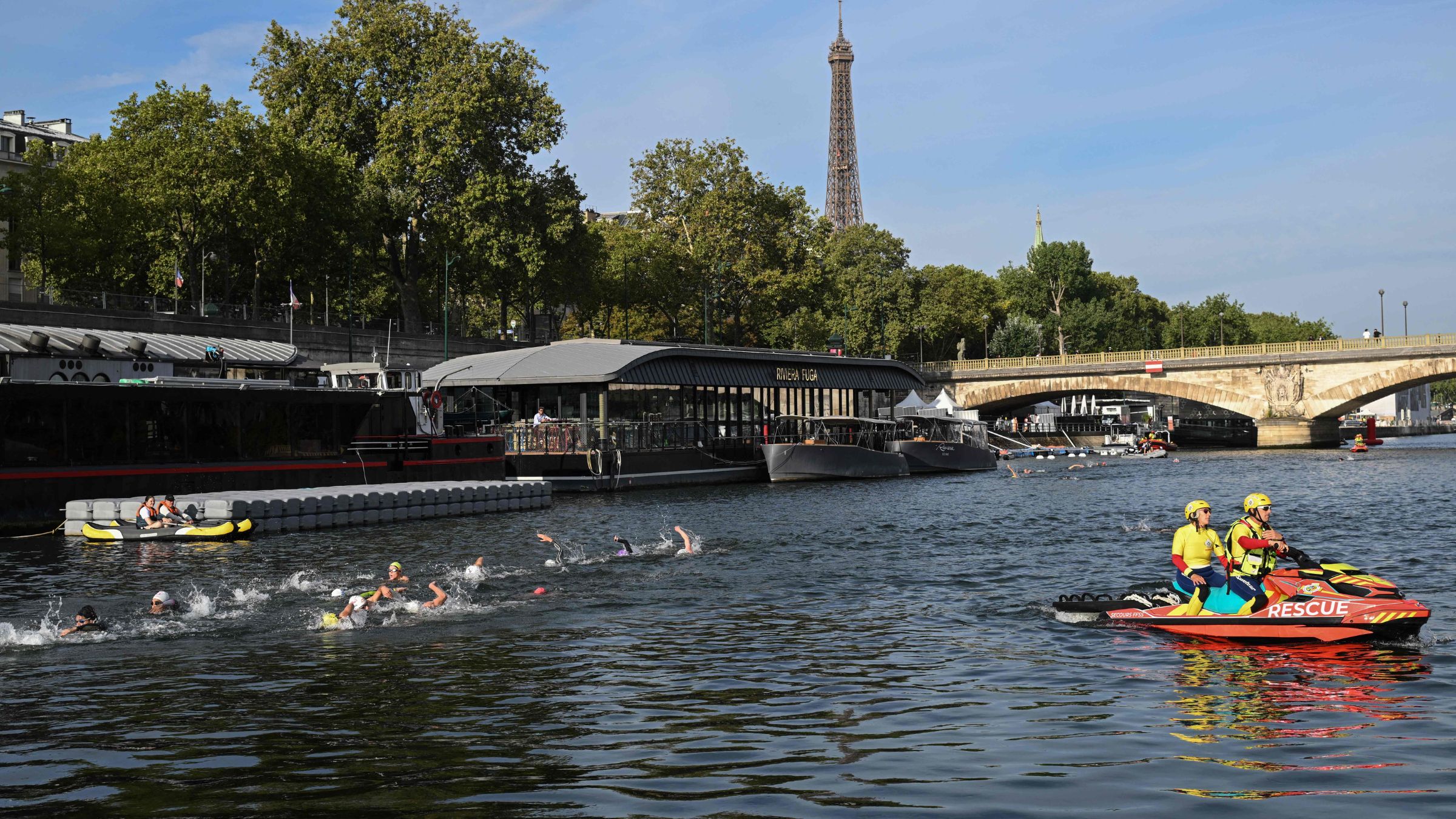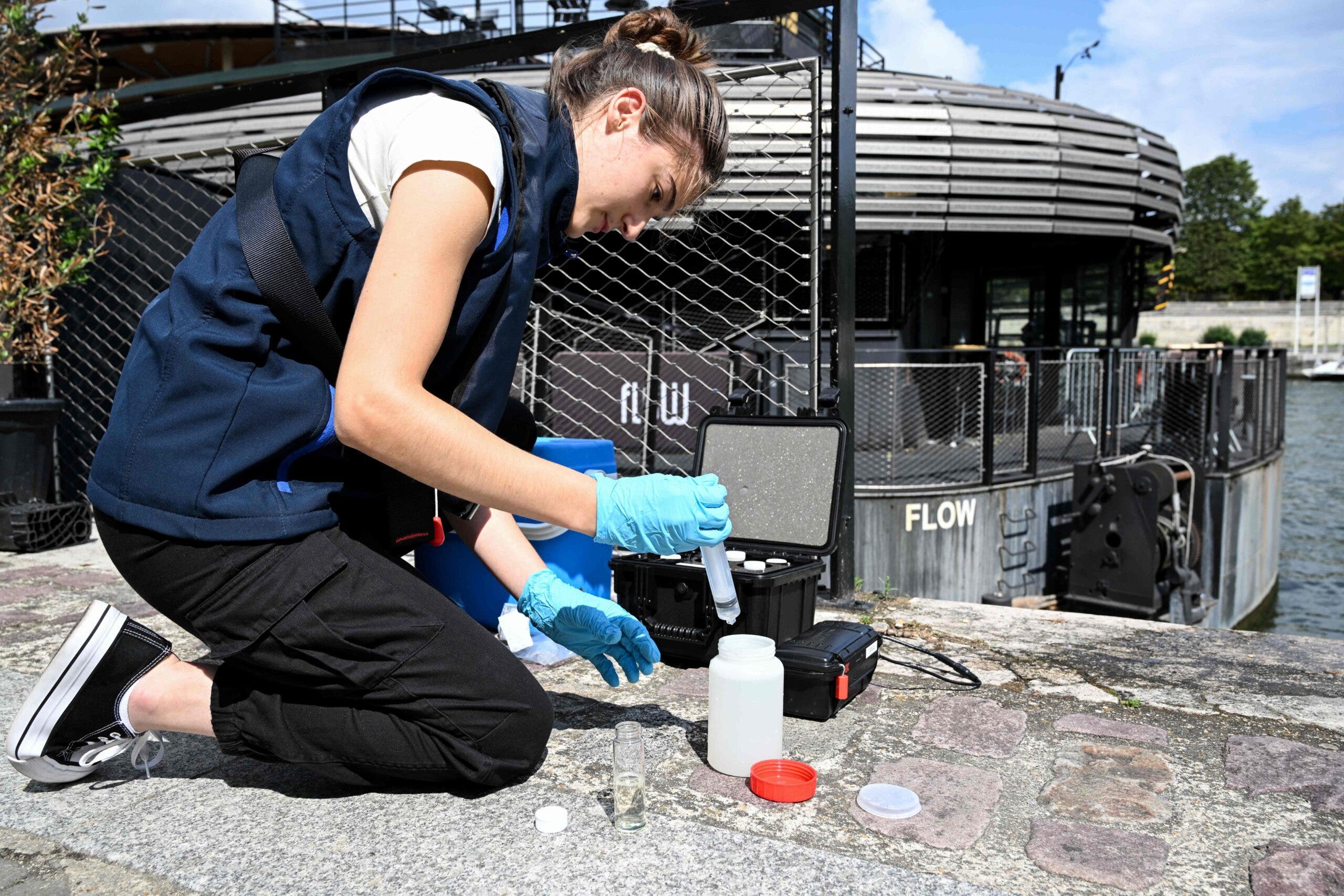An ER Doc Explains Why You Get Sick after a Triathlon Swim

Despite concerns about water quality in the Seine River, the Paris test event triathlon will take place this weekend. (Photo: Bertrand Guay/AFP)
Earlier this season, at WTCS Sunderland, 57 triathletes were reported to have fallen ill with gastrointestinal ailments. More recently, World Aquatics had to abruptly cancel their Open Water Swimming World Cup event planned in the Seine River in Paris after heavy rainfall, which caused sewers to overflow into the river, temporarily canceling out France’s heavy cleanup efforts to get the venue ready for the Paris 2024 Olympics and Paralympics. Those efforts still weren’t enough – though water tests revealed “acceptable levels” for swimming in time for World Triathlon’s Paris test event, the final two days of racing were changed to a duathlon due to issues with water quality testing. And most recently, illnesses attributed to poor water quality at the PTO Asian Open derailed the races of many of the top male pros at this year’s Ironman 70.3 World Championships.
These instances of illness and poor water quality are not new, nor are they particularly uncommon in triathlon. Over the past several years, there have been numerous cases where the swim portion of a race was canceled due to poor water quality, or of athletes complaining that they became ill when the swim wasn’t canceled (but maybe should have been). What is going on here? Why do some people get sick after a triathlon swim? Is there an explanation for why water can become particularly dangerous, and is there a way that athletes can take precautions to prevent becoming ill when the swim does take place?
Why some triathletes get sick after the swim leg
A 2019 review article in Current Sports Medicine Reports addressed these questions and helped shed some light on this issue. The authors point out that, along with the potential for infection, open-water swims are associated with significant potential environmental hazards—most significantly water temperature, with a long-established association between an increased risk of fatalities with lower water temperatures. Other environmental hazards also pose risks to swimmers in open water. These can be from rough surf, strong currents, or marine animals like jellyfish, sharks, or apparently, otters!
But cold water and otters are not linked to nausea or diarrhea after a triathlon swim. Infections are a growing concern among public health and medical professionals, and are increasingly recognized as an all-too-common occurrence after swimming in open water – even when the swim takes place in salt water or in a river with a strong current.
The connection between swimming and illness has been recognized for over a hundred years. In the early to middle decades of the twentieth century, summertime swimming in lakes or ponds all too frequently led to the contraction of polio, a virus transmitted in sewage and then ingested by swimmers leading to disease and occasionally permanent paralysis.
With the advent of the Salk vaccine, the threat of polio receded, but other diseases still contaminated the water. These mostly come in the form of other viruses – typically these are generally mild, but there are also parasites and bacteria that can be ingested from contaminated water and these can lead to more serious illnesses.
Rain and…sewage?
In 2017, researchers published a study looking at a large outbreak of diarrheal illness in swimmers at an event in the Thames River in London. The authors found that fully one third of participants contracted a gastrointestinal illness after the event and this was despite water samples demonstrating no significant bacterial contamination measured the day before. In addition, local wastewater utility managers reported no known sewage spills into the river on the day of the event. So how did so many people become ill?
It turns out that the day before the swim took place, there was an unusually high amount of rainfall detected in the area surrounding London. All that rainfall, the authors reported, washed off farmland and into tributaries of the Thames. By the time the wastewater poured into the river where the open-water swim was taking place, it was laden with all of the animal waste and fertilizer that it had picked up from the surrounding farmlands. It was this that swimmers then ingested, and they then became ill.
The impact of rainfall was dramatically shown in another paper from Denmark, where participants of Ironman Copenhagen were compared in years that were dry to those when there was extreme rainfall. In drier years, rates of gastrointestinal illness after the event measured 8%, while after a year with extreme rainfall it was as high as 42%.

Warmer water and algae blooms
Rainfall is not the only environmental factor that impacts the likelihood of swimmers becoming ill. Water temperature is another. High water temperatures, in conjunction with increased runoff from adjoining farmlands, can lead to algal blooms. In some cases, those algae may be toxic to fish and mammals. In 2019, one such bloom of toxic blue-green algae in the Ohio River led to the cancellation of the swim for Ironman Louisville. Had it not been cancelled, there would have been a significant threat to participants.
Another less-threatening condition that can be contracted from the water include something known as swimmer’s itch. Swimmer’s itch is a reaction to parasites deposited by waterfowl. These cases are generally benign, and no more than a nuisance to triathletes. But it’s still a nuisance!
Knowing all of this, what can triathletes do to mitigate their risk when participating in an event? One of the most important things that an athlete can do is just be aware. Keeping an eye on the weather leading up to an event can give a reasonable indication of whether you can expect significant runoff from farmland or spillage from sewage plants because of flooding. If there is a lot of rainfall in the forecast leading up to an event this is a warning sign that water contamination is possible.
How to avoid getting sick after a triathlon swim
If rain is in the forecast before your race, there isn’t a whole lot that you can do to reduce the chances of your swim being cancelled. Water quality is assessed on a regular basis, and it is no one’s best interest to allow an event to take place if water quality is out of line with safety standards. But because water quality is tested frequently, it is possible that a safe result comes from a day before the event, and the swim will go on.
If you still have concerns about the water quality of your swim leg, you have two options:
- Do not participate
- Limit the amount of water that you ingest
Several studies have correlated the amount of water that swimmers ingest during an event with the likelihood that they will become ill. While swallowing water is often completely involuntary, making a conscious effort to not swallow any water when diving in or breathing is a potentially viable (if challenging) strategy.
There are a couple of reassuring thoughts to consider after all this discussion. First, even if you do ingest a quantity of contaminated water that is sufficient to cause illness, the time for the onset of that illness is in most cases longer than the time it will take to complete the event. In other words, you should get to complete your event before you develop any symptoms. If you do become ill, your symptoms may be unpleasant, but are very much self-limited and rarely need medical interventions. Aside from treating the symptoms themselves, antibiotics are only needed occasionally, and most cases last no more than two to three days.
RELATED: Hotter, Harder, and More Expensive: Why Triathletes Should Care About Climate Change